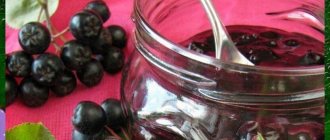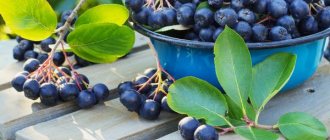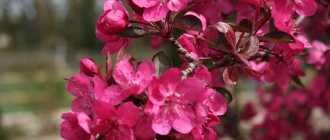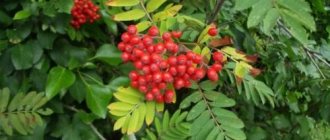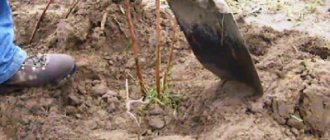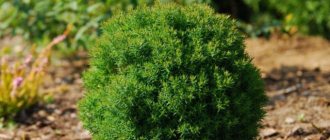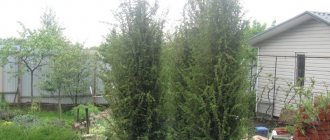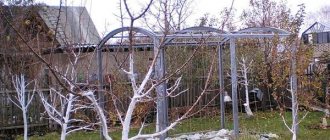Chokeberry chokeberry: description
In accordance with the botanical description, chokeberry is a highly branched shrub, reaching a height of 2.5-3 meters.
The crown of young plants is characterized by compactness, while the crown of more mature plants is spreading. The crown diameter of older shrubs varies from 1.5 to 2 meters. One bush can combine up to 50 stems aged from 2 to 9 years. The culture is very durable. With proper care, chokeberry can bear fruit for up to 30 years or more.
The leaves have a glossy surface and a simple elliptical shape, similar to that of a cherry tree. In autumn, the foliage of chokeberry turns a spectacular purple-scarlet color, which gives the plant an impressive decorative appearance. Flowering occurs in May-June and lasts about two weeks. During this period, chokeberry is covered with small (up to 1 cm in diameter) white or pinkish flowers, united in corymbs. Visually, the flowers of “chokeberry” resemble mountain ash.
Chokeberry is a self-fertile and early-fruiting crop that does not require pollinators and enters the fruiting phase in 2-3 years. Each branch bears fruit until about 6 years of age, after which its productive properties noticeably decrease. For this reason, old branches are cut out in a timely manner, making room for young branches. The same applies to the skeletal trunk, which retains its productivity for 5-7 years. After reaching this age, the trunk is cut down to the ground.
Fruiting usually occurs in the fall, at the end of August - September. Around mid-September they begin harvesting.
Excessive thickening of bushes negatively affects the productivity of chokeberry. It should be noted that during the ripening of fruits, chokeberry is difficult to tolerate moisture deficiency - in this case, its yield drops noticeably, and the fruits themselves become smaller and lose their juiciness.
The fruits of chokeberry are small (up to 1-1.5 cm) black apples covered with a waxy coating. They are edible and quite juicy, have a pleasant sweet-sour and slightly tart taste.
The plant is considered a good honey plant. Taking into account the fact that during the flowering period it actively attracts bees and other insects, it is rational to grow crops that require pollination near it. By growing honey plants near the garden, summer residents manage to avoid many problems associated with lack of harvest, poor growth of cucumbers, tomatoes and other vegetable crops.
Despite the resistance of chokeberry to low temperatures, on the eve of cold weather it is recommended to create favorable conditions for its wintering. For this purpose, spruce branches are laid out near the bushes. During severe cold weather, it prevents surface roots from freezing. If the winter is expected to be snowy and frosty, then it is advisable to bend the bushes in advance, sprinkle the ends of the branches with soil and cover the plants with brushwood to retain the snow. Snow retention measures help protect fruit buds from frost.
Medicinal properties of chokeberry
The fruits and juice of chokeberry are used to treat a number of diseases, mainly hypertension, atherosclerosis and anacid gastritis. In addition, chokeberry, due to its high iodine content, is useful for preventing thyroid diseases. In terms of their technological qualities, the fruits of chokeberry are very valuable raw materials for processing. For example, when pressing the berries, a high yield of juice is obtained (up to 80%). The fruits of this crop are an excellent food coloring. Jam, jam, soft drinks, etc. are prepared from chokeberry. from the juice - various wines and liqueurs.Dried rowan fruits retain their medicinal and nutritional properties well.
In folk medicine, the fruits of Chokeberry are used, which are collected in early autumn. Its fruits and fresh juice, in addition to the properties inherent in ordinary rowan, lower blood pressure and calm the nervous system, therefore they are used in the treatment of hypertension stages I and II.
Aronia chokeberry - beauty and benefits
Aronia chokeberry is a shrub that grows up to 3 m in height. It is winter-hardy, highly branched, and has a shallow root system . Young plants are quite compact, but over time the crown can grow to 2 or more meters in diameter. Chokeberry blooms in late spring or early summer with white or pinkish fragrant flowers that attract a large number of insects. The fruits are purple-black with a bluish bloom and ripen in late summer. In September, chokeberry leaves turn purple-red. Against their background, black bunches of berries look beautiful, which are recommended to be collected after the first frost.
Photo gallery: chokeberry is beautiful in all seasons
Confirmation that the fruits of chokeberry are valuable and beneficial for the body is their inclusion in the list of medicinal substances by the Ministry of Health.
Aronia berries contain a lot of iodine, as well as rutin, which increases the elasticity of blood vessels and slows down the aging process. They are useful for high blood pressure and help speed up the treatment of nervous and cardiovascular diseases.
The usefulness and beauty of chokeberry are undeniable and indicate in favor of its cultivation in garden plots.
Chokeberry chokeberry: varieties and forms
The plant has a number of decorative forms - such as:
- — large-size “Elata”,
- - large-leaved "Grandifolia",
- — “Subpubescens.”
Very original, but, unfortunately, hybrids of chokeberry and rowan are still not very popular. Their lesser known name is sorbaronia.
In many gardens there is chokeberry, grafted onto ordinary rowan. Standard specimens of “chokeberry” are characterized by high productivity and decorative properties.
The following varieties of chokeberry - chokeberry - are popular with summer residents, namely:
- - Finnish: Diamond, Viking, Ahonnen, Belder, Karhumäki, Hakkia;
- - Polish: Egerta, Galicianka, Dabrovitsa;
- — Aron (Danish).
The following varieties have also proven themselves well:
- - Black-eyed;
- — Venisa;
- — Nero;
- — Zerina;
- — Chokeberry;
- — Altai large-fruited;
- — Rubina;
- — Nadzeya;
- - Hugin (Khutin).
Planting chokeberry correctly
Chokeberry in Russia is often called chokeberry, but these crops are not close relatives; they are united only by belonging to the same family - Rosaceae. It is grown everywhere as an ornamental, fruit and medicinal plant. It’s not for nothing that the name of the bush is translated from Greek as “help”, “benefit”.
Selection of seedlings and varieties of chokeberry
When working on cultivating the plant, breeders focused their efforts on its zoning and adaptation to the conditions of individual regions. Many varieties have been bred, but their qualitative characteristics are basically similar. They purchase seedlings from regional nurseries or focus on shrubs that grow well among their neighbors. When choosing planting material, consider the following characteristics:
- The bush should be 1-2 years old.
- The root system is healthy, well developed, not dried out. The length of the tap root is more than 25 cm, there are many additional roots.
- The height of the leading shoot is more than 1 meter. 2-3 branches about 30 cm.
- The bark is without damage or traces of disease, the branches are healthy.
It will be enough to plant 1-2 bushes at your summer cottage. The crop bears fruit annually and will produce a harvest for 25-30 years.
Reproduction
Chokeberry reproduces by seeds and vegetatively. Gardeners usually use vegetative propagation, which allows them to get a new plant as quickly as possible. The most popular method is cuttings.
Seeds
The seeds are extracted from ripened fruits. They are ground in a sieve and then immersed in water so that the pulp remaining on the seeds is separated.
Seed propagation order:
- The seed material is subjected to stratification. The seeds are washed and placed in a container with disinfected sand - pre-heat it in the oven.
- Place the container with the seeds in the refrigerator, in the bottom drawer for vegetables.
- The seeds are planted at the end of April in the grooves. The depth of the furrows is 6-8 cm. The top of the crops is covered with soil and sprinkled with mulch.
- When the seedlings have 2 true leaves, thinning is carried out. There should be 3 cm between adjacent plants. With the appearance of 4-5 leaves, thinning is repeated, increasing the intervals to 6 cm.
- The next thinning is carried out next spring. This time, gaps of 10 cm are left between the grown young animals.
- In the autumn of the 2nd year, young seedlings can be transplanted.
While growing seedlings, the beds are watered, weeded and fed. Fertilizing is applied once - in the spring, watered with diluted manure.
Cuttings
The plant is propagated by green and woody cuttings. They are harvested at different times, the first in June, the second in September.
Propagation of chokeberry using different types of cuttings:
| Options | Greens | Lignified |
| Requirements for cuttings | Length 10-15 cm from shoot tips | Length – 15-20 cm (5-6 buds). Cut from the middle of 2-4 year old branches |
| Substrate | Mix garden soil with wood ash and compost | Coarse river sand. Layer thickness – 10-15 cm. Base – clean and loose soil |
| Environmental conditions | Optimal temperature; +20°C. Constant humidity | |
| Planting and rooting | Landing angle 45 degrees. Intervals between cuttings are 4 cm | Planted at an angle of 45 degrees. The interval between cuttings is 10-12 cm |
| Care | Moderate watering, loosening, weeding, hilling | |
The survival rate of cuttings is high - 70-100%. They are fed with ammonium nitrate (30 g per 10 liters of water) and slurry. Transplantation of seedlings to a permanent place is carried out a year later, next autumn.
Root suckers
Aronia produces many root suckers that can grow into a new plant. The shoots are separated with a shovel from the mother bush along with the roots. The shoot is trimmed so that about 4 buds remain on it. Next, the plant is cared for in the same way as ordinary seedlings.
By layering
Under the bush in the spring, dig up the soil 20 cm deep. The strongest shoots are selected. They are bent to the soil and secured with staples. The tops of the shoots are pinched. They are then cared for like mature bushes.
When the shoots from the layering reach 12 cm, they are covered with humus. The plants continue to grow, and the dusting is repeated 3-4 more times. The separation and transplantation of the “daughters” is carried out next spring.
Dividing the bush
Chokeberry has roots concentrated at a depth of up to 60 cm, so it can be dug up and divided into parts. The resulting shares are planted, resulting in several new bushes at once. When dividing, old shoots are removed from the resulting parts. Reproduction by division is also a rejuvenating procedure.
Attention!
Only generative propagation - by shoots, division, layering - allows preserving the varietal characteristics of the plant.
Vaccination
Chokeberry is grafted in the spring, before sap flow begins. The rootstocks are seedlings of ordinary rowan. A split is made on the rootstock with a sharp tool, and the scion is cut with a wedge. The shoots are tightly combined and wrapped with film to create a greenhouse effect. after a month the “winding” is removed.
How to plant chokeberry in the fall
Autumn is the most convenient time for planting chokeberry. You can have time to prepare the planting holes, leisurely select seedlings and not worry that unpredictable frosts will destroy the sprouts.
Seedlings that have ripened over the summer are less susceptible to freezing than fresh shoots during spring planting. In autumn, the root system takes root better. Its active development stops only at -4 °C.
To adapt the roots of chokeberry planted in the fall, 20 days before the onset of persistent cold weather is enough. In spring, such a plant wakes up faster and begins to rapidly grow its above-ground part. At this time, spring-planted seedlings are just coming to their senses.
Where is the best place to plant chokeberry in the fall?
Chokeberry grows well in any soil, except highly saline soils. Its root system tolerates high groundwater levels and spring floods well. Therefore, any area with enough sun is suitable for planting in the fall.
Black currants are very demanding when it comes to lighting. In shaded areas, chokeberry can be grown only as an ornamental crop. It will require a lot of light to flower and set fruit.
Planted along the border of the site, from the prevailing winds, chokeberry can serve as protection from drafts for the entire garden or vegetable garden.
How to plant chokeberry in the fall
To properly plant chokeberry in the fall, you should select and prepare a place in the garden in advance. Planting holes (50*50 cm) are dug in advance to allow the soil to shrink.
The excavated soil is enriched with the addition of humus, wood ash, and superphosphate. Drainage is laid at the bottom of the planting holes: pebbles, crushed stone, broken brick.
The process of planting chokeberries in the fall:
- Water is poured into the prepared holes to ½ volume and wait until it completely goes into the soil.
- A mound of fertile substrate is poured in the center and a seedling is placed on it.
- Having straightened the roots, carefully cover them with soil, avoiding the appearance of voids.
- After spilling water on the seating area, control the subsidence of the soil and add substrate to the edge of the hole.
- The surface can be immediately mulched to retain moisture.
The arrangement of chokeberry in autumn can be arbitrary. The culture tolerates single plantings well. For increased fruiting, maintain a distance of up to 3 m between bushes. As a hedge, chokeberry requires thickening up to 1.5 m and is planted in trenches.
Landing dates
The time chosen for work must meet two requirements: not be too warm and not precede frost. By planting chokeberry too early in the fall, when the temperature still rises above +15 °C, you can end up with a developing aerial part rather than roots.
Later, when the air temperature drops more, chokeberry is not inclined to grow branches, but grows its root system. This is especially pronounced if the plantings are mulched in the fall.
Planting dates vary from September to November, vary greatly by region and are selected depending on the climate.
Planting chokeberry
Chokeberry is an extremely hardy and unpretentious plant, so even a novice gardener should not have any special problems planting it. Here are step-by-step instructions for planting chokeberry bushes:
Step 1. Wait until autumn. The best time to plant chokeberry is autumn.
Step 2: Choose a planting location. This step is also not particularly difficult - absolutely any type of soil will do, except highly saline soil. The close presence of groundwater will also not be an obstacle to planting chokeberry - the roots of the plant do not go deeper than 50 centimeters.
Step 3. Dig planting holes. They should be at least 50-70 centimeters in diameter, and 40-50 centimeters in depth. Remember! To prevent the plants from subsequently shading each other, the distance between the holes should be at least 2-2.5 meters.
Step 4. Preparing the planting mixture. Make a mixture of the following ingredients:
- 150 grams of superphosphate;
- 2 buckets of compost, peat or humus;
- 50-70 grams of potassium sulfate.
All this must be mixed with the top layer of soil.
Step 5. Planting and pruning. When planting, remember that the root collar must be deepened by 1-2 centimeters, and immediately after that, prune the seedlings. When pruning, leave stumps 15-25 cm long with at least 5 buds.
Summer care and feeding
Rowan is an unpretentious tree in itself, and accordingly, caring for chokeberry is simple and does not contain any great subtleties. Work begins in early April with trimming and treating the trunks with lime.
Main works:
- After the “haircut” the plant experiences “stress”, so you need to cover everything with garden varnish.
- In April, it is necessary to spray the chokeberry from insects and microbes located in the bark or soil under the tree.
- In May, with the appearance of weeds, the weeding period begins; also in May, the seedlings need to be fed.
- To obtain a rich harvest, it is advisable to feed the seedlings regularly.
Supervising the chokeberry in the summer consists of observing the species so as not to miss the first moment of the development of the infection. If the first signs of illness appear, it is necessary to carry out sanitation - using folk remedies or specialized compounds.
Diseases, pests - prevention
Fungicide treatment will be required before bud break and after harvest. It is enough to spray Bordeaux mixture with a concentration of 1%.
Aronia chokeberry is resistant to pest damage. Troubles can arise when they massively damage an area. In this case, treatment with potent drugs will be required.
Chokeberry berries The rich content of nutrients, microelements, and vitamins is very attractive to connoisseurs of high-quality dietary products. They are especially attracted by the beneficial properties of chokeberry . The shrub is also grown for decorative purposes.
The hedge is very picturesque, as the photos . Those who like to decorate the site will be able to fully realize their plans. The hedge looks different three times a year, changing color from white blooms to purple foliage in the fall. Everything looks great in any season.
Watch the video! Planting and caring for chokeberry
Features of care in autumn and preparation for winter - general tips and recommendations
Like any other plant, chokeberry needs to create the most comfortable environment possible. Before the onset of cold weather, you need to have time to carry out comprehensive care, the quality of which determines the appearance and fertility in the next season. Caring for mountain ash in the fall should include the following elements:
Watering. If the autumn is dry, rowan trees need to be watered regularly. Depending on the size, 2-3 buckets of water are added under the bush, which is poured into a groove made along the perimeter of the rhizome. The next watering is carried out as soon as the top layer dries well.
Feeding. Rowan is undemanding when it comes to fertilizing: if organic matter or complex mineral mixtures were added during planting, then the bush is not fertilized for 2 years. In the future, potassium-phosphorus fertilizers are applied to the bush once every 3-4 years. For one adult bush over 5 years old, add 70 g of superphosphate and 30 g of potassium sulfate or 1.5 buckets of compost or humus.
Important! Since the roots of rowan are located close to the surface, after applying fertilizers, the soil can be dug up to a depth of no more than 8-10 cm.
Trimming. Pruning chokeberries in the fall is the most important element of autumn care. To ensure that the bush has a well-groomed appearance and delights with healthy berries, rowan berries are pruned 1 or 2 times a year.
The plant grows so quickly that if left unattended, it fills the surrounding area and stretches up to 3 m in height. Such amateur activity is unacceptable in small summer cottages, where every centimeter counts.
In addition, pruning not only promotes proper plant growth, but also improves fruit set, which is extremely rich in valuable micro- and macroelements.
Mulching. Spruce spruce branches or dry leaves are used as mulching material to cover tree trunk circles. Young bushes are mulched with a layer 10 cm thick. Organic material will not only protect the root system from frost, but will also retain moisture in the ground, which is very necessary for the plant in winter.
Shelter. Chokeberry is an extremely frost-resistant plant that is successfully cultivated even in the Far North. The plant is able to overwinter on its own without shelter even at -35 C.
Growing and care
Chokeberry is a fruit crop, and it requires much less care than many other shrubs. When growing chokeberries, special attention is paid to pruning, watering and fertilizing. If you properly care for these shrubs, they will quickly repay your care with high yields.
Top dressing
The quantity, size and taste of chokeberry fruits depend on fertilizing. If the plant is grown on fertile soils, then you can get by with a minimum set of fertilizers. In the spring, add ammonium nitrate (50 g per bush) and mulch the trunk circles with organic matter.
If chokeberry grows on infertile soils, it is fed not only in spring, but also in summer. In June, the plant is fertilized:
- mullein solution (10 l), prepared in a ratio of 1:5;
- a solution of bird droppings (10 l) mixed with water in a ratio of 1:10.
On a note!
If there is not enough food, chokeberry can be fed in the fall. When all the fruits from the bush have been collected, add a mixture of two glasses of wood ash and 100 g of superphosphate.
Watering
Watering for chokeberry is especially important in the spring, when the bush is just beginning its growing season. After watering, the soil is loosened, simultaneously pulling out weeds.
Features of watering and loosening chokeberry:
- If the weather is hot and there is no precipitation, you need to water the plant at the rate of 2-3 buckets per bush. The approximate frequency of watering is once a week.
- The chokeberry is watered not at the root, but in grooves dug along the perimeter of the tree trunk circles. The distance from the center to the grooves is 30-40 cm.
- The first loosening is carried out in early spring. During the summer, the soil is loosened several times.
- After harvesting, the soil is loosened one last time and mulched. A thick layer of mulch will protect the roots of the chokeberry from freezing.
Trimming
Pruning is a prerequisite for good chokeberry fruiting. It is necessary to prevent crown thickening and increase productivity. Unpruned chokeberry stretches upward, grows in width, and fruits form only on the peripheral branches. Pruning is carried out twice a year - in spring and autumn.
Spring
In early spring, chokeberry seedlings are pruned at a distance of 20 cm from the ground surface. In the second year, 3-4 strong shoots are taken from the shoots and their height is leveled, the rest are cut off. This procedure is carried out every spring until the number of main branches reaches 10.
To prevent the crown of the bush from becoming over-densified, it is regularly thinned out. It is advisable to combine thinning pruning with sanitary pruning. Cut off all unhealthy, dried out, damaged shoots, as well as shoots on which fruits do not form.
Autumn
If necessary, sanitary pruning is carried out in the fall. After harvesting, damaged branches may appear. Remove diseased and dried shoots.
Branches that thicken the crown can be pruned in the summer so that the bushes do not waste energy on feeding them, but direct all their energy to the fruits. Sections of large branches are smeared with pitch to avoid the penetration of microorganisms into the plant tissue.
Rejuvenating
After 8 years of life, the branches are removed. Moreover, pruning is done as close to the base as possible. A pair of shoots are left to replace them - root shoots. Every year, 2-3 adult branches are replaced. This strategy allows you to rejuvenate the bush as gently as possible.
Old chokeberry bushes are completely rejuvenated. They are completely cut off, right to the root. A new shrub is formed from the new growth. The time of rejuvenation is spring.
On a note!
In chokeberry, only branches that are no more than 8 years old bear fruit.
What is autumn pruning
Chokeberry is a bush, which is why it always produces a lot of shoots every year. As they spread, they fill a large area, making the base extensive. Mature branches go up. At the same time, growing shoots develop, creating a dense crown. If you leave it to chance, then after some time the bush will begin to produce less fruit. Only the outer branches that receive the right amount of light will bloom and bear fruit. But the berries will not be juicy and large, since the nutrients are consumed by a large amount of the green part of the bush. Problems with the chokeberry harvest are inherent in old and neglected bushes. Regular and timely care for chokeberries makes it possible to maintain chokeberries in a healthy state.
Removing branches allows you to solve many problems at once. Among them are limiting growth, maintaining the decorative appearance of the bush, optimal lighting for uniform distribution of berries, good ventilation and maintaining the health of the plant as a whole. In regions with short summers, pruning is done in the fall, after the leaves have fallen and the crops have been harvested.
Attention! The branches bear fruit in 5-8 years. Their pruning is carried out along with rejuvenation.
Shrubs must be trimmed before the sap flows. Usually this is spring – March/April. However, it is not always possible to provide care during this time. Another option is to prune in the fall. Elimination of growth at the base of the bush is carried out throughout the fall.
Required materials and tools
It’s easy to assemble a set of necessary tools for annual care of berry bushes. It includes:
- garden pruning shears with curved blades for branches up to 2.5-3 cm in diameter;
- garden or carpenter's saw - for old and thick branches;
- freshly prepared garden pitch or crushed coal.
The cutting part of the saw and pruning shears is carefully sharpened before use. Otherwise, the cut will weaken the branch and the plant will hurt.
Trimming Features
In chokeberry, branches that are 8-10 years old are considered old, having lost the ability to lay flower buds and bear fruit. Bushes up to seven years old are classified as young.
Young rowan
Young shrubs in the first year of life do not need pruning. Experienced gardeners begin to form the crown of chokeberry in the second year of the plant’s life in the fall. All young, frail growth, which grows at a great distance from the planting site of the bush, is removed in a sector during the summer. This does not cause any harm to the chokeberry.
Old
With age, chokeberry degenerates, and it requires mandatory radical shaping at 10-15 years of age, that is, “planting on a stump.” After complete removal of the entire above-ground part, a new crown is formed from the young shoots. In subsequent years, the procedure for replacing old branches is repeated regularly.
Old branches must be cut off at the root to avoid infection of the root system from the outside through open wounds.
Trimming scheme
After planting young chokeberry, which is grown or transplanted from seeds, the growth does not need to be shortened. In the first year, the plant’s energy will be spent on adaptation and root development. Then young branches will appear and then you need to form a bush.
The procedure is performed as follows:
- Maintain 3-4 maximally strong branches. Other shoots, like those that will grow in summer, are removed at ground level.
- Over the next 4 years, the procedure is repeated. Each time, 3-5 young shoots are left. As a result, by the 6th year there will be approximately 10-12 branches of different ages at the base.
- In subsequent years, sanitary pruning is performed. At the same time, broken, weakened and frost-damaged branches are removed. The basal shoots are pruned, and the density of the crown must be controlled.
- The plant is rejuvenated at approximately 7-8 years. Branches older than 8 years are eliminated completely. They don’t even leave stumps, as they may be affected by diseases and pests in the future. In order to replace the eliminated branches, the same amount of healthy growth is left.
This repeats the process of replacing branches. As a result, the bush is constantly rejuvenated without losing productivity. When forming, you need to monitor the crown. Large branching will certainly lead to thickening, and a lack of light will lead to loss of yield. It is necessary to eliminate the inward and unnecessary shoots. There is no usefulness from them, since useful elements are simply wasted.
How to form a bush
When forming a chokeberry bush, it is important to monitor the shape of the future crown. Excessive branching will lead to thickening of the bush. Internal sprouts will not have enough light and warmth. An excessively bulky crown will occupy a large area and choke out neighboring plants.
Most varieties of chokeberry form berries on last year's growths, so it is recommended to stimulate the growth of current year's shoots.
A properly formed chokeberry bush consists of 10-15 full-fledged branches of different ages. The optimal height of a chokeberry bush is 1.5-2 m, diameter is 1.5-2 m.
Nuances of care
Caring for chokeberry is easy. They begin gardening work after the snow melts. While the buds are in a dormant state, sanitary and shaping haircuts are carried out, and the trunk is limed. The plant should be sprayed a little later, when stable positive temperatures have been established, since most drugs are ineffective below 10 °C. The rest of the agricultural technology is standard.
Watering
The culture is drought-resistant. If the winter was snowy, precipitation fell in the form of rain in spring and summer, additional watering will not be required. However, for lush flowering and abundant formation of ovaries, full ripening of berries in hot, arid climates, the plants are moistened. It is better to use settled water, free of chlorine and heavy metals.
Soil treatment
After watering, the soil under the crown is loosened. Since the roots are located close to the surface, you should not bury the hoe more than 5 cm. At the same time as loosening, weeds are removed, which take away nutrients and moisture from the chokeberry. If an adult plant does not experience severe stress from this, then weeds can harm young plants, significantly weakening them. To preserve moisture, it is recommended to cover the soil in the tree trunk circle with mulch, which includes sawdust, peat, and compost.
Feeding and fertilizer
In the wild, chokeberry also grows in very poor soils. But to increase decorativeness and obtain a rich harvest, it is worth feeding the plant, adding macro- and microelements required at different phases. In the spring, nitrogen-containing complexes are applied under the rowan. They stimulate branching, active growth of foliage, and the intensity of its color. During the budding and fruiting phases, the plant is fertilized with phosphorus and potassium, which are responsible for the formation of berries and their ripening.
For your information!
To strengthen the immune system, the crop is fed foliar by spraying the crown.
Trimming
In order for chokeberry to bear fruit and have strong immunity, it must be pruned. More often the culture is formed in the form of a bush, but growing chokeberry as a tree is very decorative. The crop is formed into one trunk in the spring, when it reaches the required height. The lower weak shoots are removed, leaving only 4-5 branches as skeletal branches. Rowan trees are pruned not only in spring, but also in autumn. However, the goals of haircuts are different.
Spring
This is the time for a shaping haircut. More often, chokeberry is cultivated as a bush. With the onset of next spring, after planting, the seedlings are shortened to a height of 15-20 cm. After a year, several shoots are left, leveling them in height, and the rest of the shoots are cut out. Every spring, several developed branches are added to the bush from root suckers. When there are 10 of them, the plant is considered to be formed.
Sanitary pruning, which prevents the bush from becoming too overgrown, is also carried out in the spring. Remove weak shoots growing inward. The latter can compete with skeletal branches and do not allow light to pass into the center of the bush, which will lead to a shortage of harvest. Since chokeberry has productive shoots that are not 8 years old, the older ones must be cut off. This is done right at the root, without increasing the diameter of the base.
For an old bush there is also a rejuvenating pruning. It is carried out before the buds begin to swell, when all shoots are completely shortened. Meeting the deadlines will help the plant undergo the procedure painlessly. Make sure that all branches are cut flush. Over time, new root shoots will begin to grow. It is formed according to the same scheme that is used for a newly planted plant.
Haircut in autumn
After harvesting, when the gardener sees that the rowan tree has broken branches affected by diseases and pests, the plant is pruned, since chokeberry cannot go into winter in this condition. However, you cannot surprise many branches: this will weaken the plant, it will use all its strength to restore itself instead of preparing for the cold. After removing thick branches, the sections are treated with garden varnish. An important rule that should not be forgotten.
Propagation of chokeberry
The crop is propagated by all known methods: cuttings, seeds, layering, dividing the bush, grafting. Cuttings from green and woody cuttings are one of the most productive methods of propagation. To increase the efficiency of the process, growth stimulants are used. Green cuttings are cut from young bushes for rooting in the current season in a greenhouse. Cut blanks from annual shoots into 4-5 buds. Leaves are cut off from the lower two internodes and left on the upper ones. The blanks are planted in greenhouses at an angle in fertile, loose soil at a distance of 4 cm from each other so that 2 buds are immersed in the soil. Maintain a temperature of 20°C and constant planting humidity. Rooting takes 2-3 weeks, after which the sprouts are transplanted from the greenhouse to the growing area. Next autumn the seedlings will be ready for planting.
Woody two-year-old shoots are cut in mid-September and stored tied in snow or in the refrigerator. Planted in spring. Water, mulch the planting, and insulate the sprouts before the winter cold.
Reproduction by horizontal layering
Quite a productive way. The bush intended for propagation a year before the procedure is thinned out. After thinning, young flexible shoots will begin to actively grow. Select developed one- and two-year-old branches from the outer part of the bush.
Bend the shoot into a groove with fertile planting mixture and secure with brackets. When the sprouts appear and reach 5 cm, they are covered almost completely with soil. When the sprouts reach 10 cm, they are again sprinkled with a 4 cm layer of earth. If the weather is dry, after sprinkling, watering and mulching are performed. Layers are separated in the fall of next year. The strongest seedlings are planted on the plot, the weak ones are grown in the greenhouse.
Reproduction by grafting
Any of the grafting methods is suitable for propagating chokeberry. Grafting is done in the spring. As a rule, a rowan seedling is chosen as a rootstock. Butt or bark vaccinations are popular.
Propagation by seeds
To obtain seeds, take the most ripe berries, mash them, soak them, rub them through a sieve, obtaining seeds with pulp. After drying, the seeds are easily separated. They are washed, dried, stratified (hardened). For hardening, place in linen bags (or in glass jars) in the refrigerator on the bottom shelf. Sow in spring in furrows 5 cm deep, cover with soil, and maintain constant soil moisture until sprouts appear. The seedlings are thinned out in several stages, leaving the strongest seedlings. The first thinning is 3 cm from the moment 3 leaves appear. The latter is 10 cm in the spring of next year.
Hilling up the base of the bush with soil
This is a low-productivity method; the seedlings are weak; they are grown in a greenhouse.
Dividing the bush
In the spring, before the growing season begins, the bush is dug up and divided into several parts. Old branches are removed. Several young branches and well-developed roots are left on each part. The seedlings are planted in the usual way immediately on the planned area of the site.
Caring for chokeberry after planting
Agricultural technology for young plants consists of mandatory procedures:
- Watering abundantly. It is carried out in the initial period after planting 1-2 times a week, more often during dry periods.
- Loosening and removal of weeds is carried out for young plants after watering, for older plants at least 2 times per season.
- Pruning root shoots in spring. Leave 5-6 of the strongest ones, directed in the right direction.
- Fertilizing (in spring with nitrogen, in autumn with complex fertilizers).
- Treatment against pests and diseases in early spring.
Transfer
Chokeberry bushes can be replanted even in adulthood. Chokeberry tolerates replanting well; the main thing is to replant the plant quickly and correctly, preventing it from withering.
Transplant timing
Chokeberry can be replanted in spring or autumn. Preference is given to autumn transplantation. Shrubs, having grown stronger over the summer, better survive the stress associated with changing location. In order for plants to adapt faster, their shoots are shortened by half and their leaves are thinned out. Freeing some of the shoots reduces the load on the root system, and the shrub takes root faster.
In spring, the root system may not be able to cope with the double load, and the plant will slow down, weaken, and take a long time to take root. If the transplant is still carried out in the spring, then it must be done before the sap begins to flow.
Transfer procedure
You can transplant both young and fully grown chokeberries. The main thing is to move the bush to a new place with a lump of soil. Replanting allows you to rejuvenate the chokeberry, reduce the load on the roots and get several plants from one at once.
Transfer order:
- Dig a ditch 0.5 m deep and 0.25 m wide in a circle.
- Using a crowbar or shovel, lift the roots of the plant and move them out of place.
- The bush can be placed on a bag or thick film and carefully move it to a new place. A landing hole must be prepared there in advance.
- Place the bush in the hole, water it and cover it with fertile soil.
- Trim damaged and dry branches from the bush. Sprinkle the cuts with charcoal.
If the bush is large, it can be divided into parts. The root system is cleared of soil and the bush is cut with a sharpened tool. Each division should have healthy roots and 3-4 shoots.
Attention! When replanting chokeberry, its previous orientation in relation to the cardinal points is preserved in a new place.
Landing
If you decide to grow this beautiful and useful plant on your plot, then you need to know when, how and where it is preferable to do it.
When to plant chokeberry
There is no clear answer to the question of when it is better to plant chokeberry: in autumn or spring. It all depends on weather conditions, soil quality, the gardener’s availability of free time and other factors. Each season has its pros and cons that must be taken into account when making a planting decision.
Autumn planting
Autumn is a great time to plant chokeberries. The optimal planting time is from late September to early November. They can be called floating, since it is necessary to take into account the characteristics of the climatic zone and weather conditions. The main guideline for starting planting is the plant’s entry into a state of biological dormancy, which occurs after the leaves fall from the bush. Advantages of autumn planting:
- benefit. In autumn, seedlings of the crop are more affordable in price and variety of varieties;
- ease of landing. Autumn planting does not cause much trouble. After planting, the plant is watered, and then nature takes over;
- comfort. The plant itself will be dormant, but before the onset of frost it will have time to grow thin, absorbent roots. Autumn humidity and temperature conditions are comfortable for this process. In addition, during the winter the soil around the seedling becomes compacted, so autumn plantings begin to grow much faster than spring ones;
- saving time. In the fall, gardeners have much less trouble than in the spring.
Disadvantages of autumn planting:
- chokeberry seedlings can be damaged by severe winter frosts, especially in northern regions;
- In addition to frost, winter threatens seedlings with other troubles: icing, strong winds, snowfalls. They can break a young plant;
- in late autumn and early winter, rodents become active and can damage the roots of seedlings.
Rodents can damage chokeberry seedlings planted in autumn
Spring planting
The plant tolerates spring planting well. The main thing is to carry it out in compliance with all the features of the procedure and early enough - before the end of April. Spring planting has its positive and negative aspects. The advantages of planting chokeberry in the spring include the following:
- in the spring, when planting is being planned for the current year, you can prepare planting holes in advance, since the area is practically free of other plants, there is no need to wait for harvesting and the release of the planned place;
- although the plant will begin to grow later, it has a whole growing season ahead of it, which means it can get a harvest next summer. If you delay planting until autumn, the fruiting of the crop will be delayed for the whole season.
Disadvantages of spring planting chokeberry seedlings:
- increased attention and care. Spring seedlings need to be watered regularly, especially if the spring is windy and dry;
- lack of good planting material;
- In the spring there is much more work in the garden and vegetable garden than in September - October: preparing the soil, growing seedlings and caring for them, sowing vegetables and other important activities.
Where to plant chokeberry
Chokeberry is a perennial plant; it can grow well and bear fruit in one place for up to 30 years, so you should approach the choice of a site for planting with all responsibility.
The best predecessors for chokeberry are perennial grasses and green manure.
Chokeberry is undemanding to soil. The plant is preferably planted on moist loamy soils with neutral acidity. But at the same time, it will grow normally on soils with high acidity, pre-treated with dolomite flour or lime, as well as on sandstone. Chokeberry does not suffer from close groundwater, as it has a superficial root system located no lower than half a meter from the surface. Chokeberry grows poorly only on highly saline soils. However, in areas with insufficient moisture, chokeberry berries may be small and dry.
Aronia chokeberry is undemanding to the soil and grows poorly only in saline soil.
For excellent flowering and an abundance of fruits, the crop requires good lighting. With strong shading, including internal shade, the bush will stretch upward excessively. Chokeberry goes well with garden and vegetable crops.
It is not recommended to plant chokeberries next to cherries, as these plants have common pests: slimy sawfly and aphids.
Chokeberry is often used to organize hedges, as well as for group plantings. The grafted chokeberry can be shaped into a ball and will serve as an original decoration for the site if you use mountain ash or hawthorn as a stem.
Recent Entries
5 working ways to use tar in the garden 7 indoor plants that help you get married even in adulthood Indoor plants that can bloom in trouble
A chokeberry hedge has a beautiful appearance, a dense crown, low growth and is easy to trim and care for.
Landing rules
The methodology for planting crops in autumn and spring is identical. When planting chokeberry, it is important to have healthy seedlings. When choosing them, first of all, it is necessary to take into account the condition of the root system.
Dry, weathered roots indicate that the plant will not take root well and will be sick for a long time.
If there is a need to transport seedlings, they must be carefully covered, protecting them from drying out and freezing. Immediately before planting, it is recommended to inspect the seedling, remove dried and damaged roots and shoots, and then dip the root system in a mash of clay, water and manure.
Planting is best done in the evening in cloudy weather. The planting holes should be about half a meter in diameter and depth. If you are planting several plants, you should ensure that the feeding area for each is approximately 2x3 meters. The soil mixture for backfilling the seedling includes the following elements:
- topsoil and humus (1:2);
- superphosphate (150 g);
- wood ash (300 g).
The process of planting chokeberry includes the following steps:
- The prepared mixture is used to fill the third part of the planting hole.
- Add fertile soil, filling the hole to half its volume.
- Water using at least 10 liters of water.
Before planting the seedling, the soil in the planting hole is watered - The seedling is placed in the center of the planting hole, making sure that the root collar is buried no more than 2 cm.
- The roots are carefully straightened.
- Fill the hole with the remaining soil mixture and fertile soil.
- Pack tightly.
When planting a shrub, the root collar is buried into the soil by a maximum of 1.5–2 cm and the soil is compacted tightly
- Water with a bucket of water.
- Mulch the ground around the seedling. Straw, peat, and sawdust can be used as mulch.
If the seedlings had a well-developed root system, then the above-ground part of the plant after planting does not need to be cut off. Otherwise, it is recommended to trim the shoots, shortening them to 15–20 cm and then making sure that a few healthy buds remain on them.
Video: instructions for planting chokeberry
Harvesting
In the middle zone, chokeberry ripens in the first half of September, but earlier ripening is also possible, for example, in the third ten days of August. Suitability for picking can be determined by the bluish waxy coating and intense black color of the berries. For processing, the fruits are removed without the shields. For long-term storage, the berries are collected with scutes, but in such a way as not to damage the ringlets located at their base. It is better to pack fruits for storage in boxes with a capacity of up to 8 kg. At a storage temperature of up to 10°C and a humidity of 80-85%, chokeberry fruits can be preserved for up to two months. When frozen, they easily keep throughout the winter. You can store the fruits dried. The berries are dried in stoves or ovens at a temperature of 50-60°C. After drying, the fruits are stored in a hermetically sealed container. Both frozen and dry fruits lose their excessive astringency, become sweeter and more palatable, and do not lose their medicinal qualities.
It is important that the fruits ripen at the same time and can withstand long-term storage, up to two to three or more months, even just in a cool place.
For amateur gardeners, chokeberry is also an excellent skeleton-former for pears, and possibly other pome crops. The value of chokeberry as a skeleton-former is associated not only with the fact that it is winter-hardy, but also with the flexibility of its branches - you can cover low-winter-hardy, but high-quality pear varieties grafted onto them under the snow. A truly universal crop with many uses! Taking this into account, it is advisable to plant chokeberry not only in creative, but also in consumer, and in conditions unfavorable for gardening, and in commercial gardens.
Why replant rowan
Even more, the tree has to be moved to a new location.
Sometimes gardeners, instead of buying a seedling, go into the forest and choose the bush they like. The strengthened plant is quickly accepted. Wild chokeberry, as a rule, is more resistant to disease and less afraid of pests. In addition, independent “harvesting” of a plant, unlike purchasing it, will not cost a single ruble. The landing process will not differ from the standard one. The main thing is to choose a plant that is not infected with fungus. Rowan tree transplantation will be necessary if the place where it was planted was not designed for a large tree. Branches touching electrical wires create a flammable situation. If you don't want to trim them, the plant needs to be moved further away from the transmission line. You will also have to choose a new place for the rowan tree if it is located too close to the house. Roots can damage the foundation, reducing the life of the building.
Sometimes a young tree begins to die after planting. If even proper care does not help correct the situation, the cause may be in the soil. By nature, rowan is an unpretentious plant that feels good in almost any soil. Chokeberry is planted in peat bogs, black soil, sod-podzolic and gray forest soils. However, the seedling will quickly die in a wetland. If the leaves wither and the branches begin to dry, the plant must be moved to a more familiar soil. Then there is a chance that the rowan will get stronger and grow into a large fruit-bearing tree.
Diseases and pests
By planting fruit trees on their plots, they expect to grow and harvest a good harvest. But, as often happens, the world of gardening encounters many problems with plants, the most basic of which are diseases and pests. All diseases, without exception, can lead to a decrease in yield, and in some cases, to the death of seedlings, so it is necessary to notice the symptoms of the disease in time. By noticing the signs of infection in time (at the beginning), you can save not only the diseased tree, but also the plants growing nearby.
Below is a list of the main diseases affecting this type of plant:
- Peripheral wood rot. Occurs due to the influence of honey mushrooms. You can remove the infection: 1% Bordeaux mixture (any other type of fungicide can be used); completely dig up the bush (with roots) and burn it.
- Rotten berries - moniliosis. Under the influence of this disease, the berries become soft, greatly lose color (brightness) and become covered with cobwebs (mummified). Spore-bearing pads appear on the outer shell of the fruit (color: light brown). If you do not cut off the affected berries, there is a high risk of infection of the entire bush in the spring.
- Septoria spot - usually appears in July, in the form of oval spots (light brown) with a dark border. In the case of a prolonged disease, the dark inclusions spill out and the leaf profile becomes a “hole.” If the tree is infected, all infected leaves must be collected and burned.
- Comb fungus is a fungus that appears on a seedling due to rot. The appearance consists of white or brown-gray plates. Treatment consists of cutting and burning all infected branches.
The diseases listed above are not all, so it is necessary to constantly monitor the appearance of the seedlings.
Below is a list of pests for chokeberry:
- Ticks (brown and red) are very small insects that attack all fruit plants in the area. You can get rid of them by spraying with any chemicals produced to control pests.
- Aphids are sucking insects that are also carriers of various diseases. Most often, young bushes suffer from aphids.
- Hawthorn is a caterpillar that eats first the buds, and then the flowers and leaves of the plant.
- The mountain ash moth and the slimy cherry sawfly are insects that destroy both berries and tree leaves. To avoid infestation and insect development, it is necessary to cleanly and scrupulously remove leaves and burn them every fall and spring.
Important! Always on time: remove (burn) foliage under seedlings, cut out all damaged branches and collect all fruits, as well as spray.
The following medications help with most parasites and diseases:
- Karbofos;
- Abiga-pik;
- Copper oxychloride;
- Karbofos;
- Nitrafen;
- Bordeaux mixture;
- Decis;
- Ambush;
- Zolon;
- Chlorophos;
- Oleocuprite, etc.
If such problems arise with the tree, you should consult with the seller at a specialized gardening center.
Caring for chokeberry in the fall, preparing for winter - the actions are simple and not complicated. There are a number of features, failure to comply with which can lead to disastrous results (the worst thing is the death of the seedling), namely:
- Do not leave many small shoots (more than five) in the crown, because after they grow, your bush will turn into a “dense” tree.
- Do not feed rowan abundantly, because fertilizer only brings growth to the greenery, and not to the berries.
- If you are late in covering the bush, the branches will freeze and, as a result, most of them will break (at subzero temperatures, branches are difficult to bend).
Spring planting
When purchasing chokeberry seedlings, the first thing you should pay attention to is the roots. They must be healthy and powerful. A good root system must have at least two branches, and their length reaches thirty centimeters. Dry and weathered roots rarely take root, but even if the plant takes root, the period of its illness after planting will be very long. But you can easily get out of this situation. To do this, seedlings with such roots are placed in water for several days so that the root system gains moisture and can restore its former elasticity.
You need to pay attention to the bark. In a living seedling, its inner side is green, and seedlings with brown bark rarely take root. This is a clear sign that it was dug out a long time ago.
Before planting, all dry branches and roots must be removed from the seedling and only then placed in a clay mash. Try to choose a cloudy evening to plant the plant. If other trees or shrubs will grow in the same area with it, then place the bush at a distance of three meters from them. This will provide the chokeberry with good lighting and it will be much easier for you to care for it later.
The diameter and depth of the hole are the same and equal to fifty centimeters. Before lowering the bush into the hole, it is necessary to prepare the soil. The infertile layer of soil must be mixed with one bucket of humus, and three hundred grams of wood ash and one hundred and fifty grams of superphosphate must be added there. Mix all this well and fill a third of the dug hole. But the hole must be half filled , so the remaining space must be filled with fertile soil from the top layer. After this, you still need to pour a bucket of water there.
Only after the water has been completely absorbed can the seedling be placed in the hole. It should be located right in the middle and go into the ground so deeply that the root collar is under a two-centimeter layer of soil. The roots should be carefully spread over the entire hole, sprinkled with fertile soil and trampled down well. After this, watering is carried out again with the same amount of water as the first time. The final stage of planting is mulching, for which straw, sawdust or peat are used.
And also after planting, it is recommended to shorten the shoots by twenty centimeters so that there are 4-5 buds left on them.
What are the errors?
Despite the fact that caring for rowan trees is not difficult, you can do it incorrectly. To prevent this from happening, certain points need to be considered. Firstly, sometimes a lot of extra fertilizer is applied. A large amount of nutrients provokes accelerated growth of greenery, which reduces yield. Secondly, when pruning small shoots remain. Small shoots are weak and soon turn into full-fledged branches. This thickens the bush. When there are more than 5 such shoots, then next year the plant will look like a hopeless bush.
Features of cultivation in the regions
The yield of chokeberry depends on the growing region. The plant shows good yields in central Russia, Siberia, and the Urals. Each region has its own nuances of agricultural technology.
Features of growing chokeberry in:
- Central region and Moscow region. Chokeberry is especially productive here. The climate here is relatively mild compared to Siberian conditions. The greatest danger is winter without snow. The roots of the plant freeze at minus 11°C.
- In the Urals, Siberia, Yakutia. The shrub can tolerate frosts down to minus 35°C. To prevent the shoots from freezing, they are bent to the ground in the pre-winter period. It is necessary to apply nitrogen fertilizers in a timely manner. An excess of them can prevent the bushes from preparing for winter. As a result, the root system of chokeberry may freeze or even die. The most common disease in these regions is brown spot.
- Primorye. Chokeberry is grown here on moist soil, loamy or sandy loam. If the summer is dry, the fruits become small, tasteless, and lack juiciness. In Primorye, chokeberry grows only when the roots are insulated. The trunk circles are filled with compost or humus. Layer thickness – 5-10 cm.

